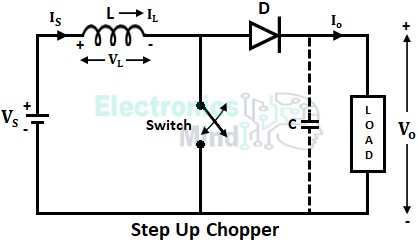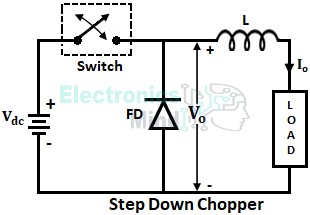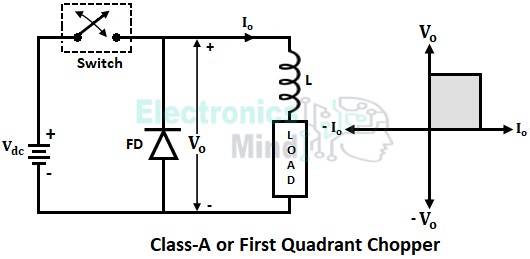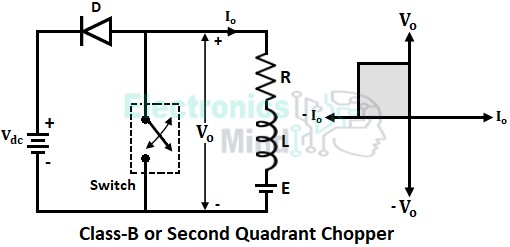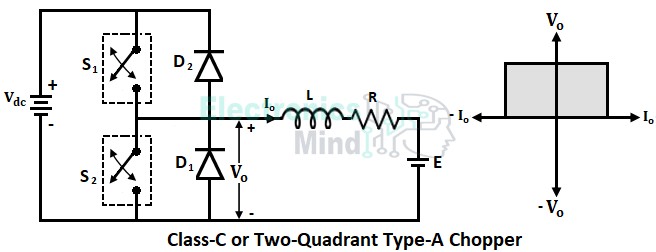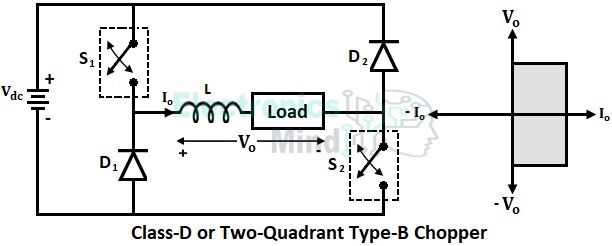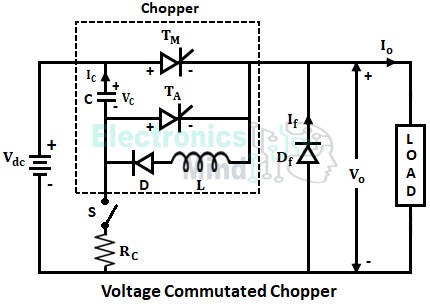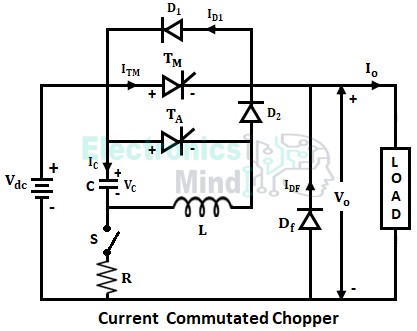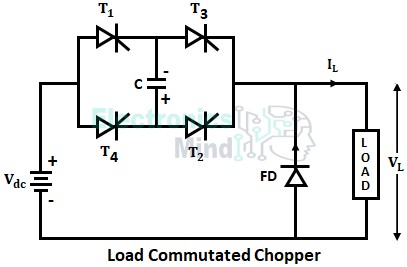For better performance and controllability there is a requirement for variable-voltage dc power supply in various applications like electric vehicles, lighting applications, tractions systems, switched-mode power supplies (SMPS), consumer electronics, communications systems, etc.
Thus there is a need for a converter that converts a fixed-voltage dc source into a variable-voltage dc source. A dc-to-dc conversion can be done either by using a resistance controller, motor-generator set, ac link chopper, or dc chopper (dc-to-dc converter).
The conversion of a fixed-voltage dc source into a variable-voltage dc source using a dc chopper is an efficient way compared to other methods due to its compact size, less maintenance, low cost, and smooth control.
A dc chopper or dc-to-dc converter uses power semiconductor devices (MOSFET, BJT, GTO, or thyristor) for the conversion of dc power from one level to another level. These power semiconductor devices will act as switches where it connects and disconnects the load from the source at regular intervals so that a chopped output voltage is obtained. Let us see the various types of dc choppers and their circuit configuration.
Classification of DC Choppers :
There are various types of choppers or dc-to-dc converters used in different types of applications. The below shows the classification of dc choppers,
- Based On Output Voltage,
- Step-up chopper
- Step-down chopper
- Based On Direction of Output Voltage and Current,
- Class A (type-A) chopper
- Class B (type-B) chopper
- Class C (type-C) chopper
- Class D (type-D) chopper
- Class E (type-E) chopper
- Based On Commutation Method,
- Voltage commutated chopper
- Current commutated chopper
- Load commutated chopper
Step Up Chopper :
A step-up chopper is a power electronic circuit that produces a higher voltage than the input voltage at the output side. It is similar to an ac step-up transformer that increases the voltage level of a dc source. The below figure illustrates the circuit arrangement of a step-up chopper.
When the switch is ON, the inductor is connected to the source, and the inductor stores energy during the ON period of the switch. When the switch is OFF, the inductor will start discharging in the reverse direction through the diode and load.
Thus load receives power from the source along with the inductor during the OFF period of the switch i.e., inductor voltage adds to the source voltage. In this manner by controlling the switch, a higher average voltage than the input voltage is obtained at the output side.
Step-down Chopper :
Similar to the step-up chopper seen above, there is a chopper circuit capable of giving a dc voltage smaller than the input voltage. This type of chopper configuration is known as a step-down chopper. A step-down chopper is similar to ac step-down transformer that can produce a voltage ranging between zero and input voltage level.
During the switch ON period, the source is connected to the load thus load voltage will be equal to the source voltage. When the switch is OFF, the load voltage becomes zero, and the load current will flow through the freewheeling diode (FD). In this manner, a chopped dc voltage is produced at the load side.
Class-A Chopper :
A class-A chopper is a type of chopper that operates in the first quadrant. The term first quadrant means the output voltage and current of the circuit will occur only in the first quadrant of the output voltage and current graph. In class-A chopper power always flows from source to load and it is also known as the first quadrant or type-A chopper.
During the ON period of the switch, the load is connected across the source, and during the OFF period of the switch, the load current flows through the freewheeling diode in the same direction. Thus average output voltage and current remain positive and power always flows from source to load during the whole operation.
The output voltage of the class-A chopper circuit is always less than the input voltage, thus a class-A chopper is a step-down chopper. This type of chopper circuit will be used to control dc motors.
Class-B Chopper :
A class-B chopper is a chopper that operates in the second quadrant. The term second quadrant means the output voltage and current occur only in the second quadrant of the output voltage and current graph. In a class-B chopper, power flows from load to source and it is also known as the second quadrant or type-B chopper.
When the switch is ON, the load gets short-circuited through the switch, and thus load EMF stores energy in the inductor. When the switch is OFF, the charged inductor will start discharging in the reverse direction due to which the output voltage will be the sum of inductor voltage and load EMF. Thus diode gets forward biased and power flows from load to source.
Therefore, the average load voltage will be positive, and the average load current will be negative. Since the power flow is from high voltage i.e., load, to low voltage i.e., source, this circuit is also called a step-up chopper. The class-B chopper circuit is used in the regenerative braking of dc motors.
Class-C Chopper :
A class-C chopper is formed by combining class-A and class-B choppers in parallel. It can operate in the first quadrant (where output voltage and current are positive) as well as in the second quadrant (where the output voltage is positive and output current is negative). A class-C chopper is also known as Two-Quadrant Type-A Chopper.
In order to operate a class-C chopper in the first quadrant, switch S1 and diode D1 will be in operation. For the second quadrant operation, switch S2 and diode D2 perform the functions. In this chopper power can either flow from source to load or load to source.
Class-D Chopper :
A class-D chopper is also a two-quadrant chopper that can operate in the first and fourth quadrants of the output voltage and current diagram. In this chopper, the load voltage can be either positive or negative but the load current is always positive. The below shows the circuit topology of a class-D chopper.
In the above figure, when switches S1 and S2 are in function, the circuit will operate in the third quadrant, and when diodes D1 and D2 are in function, the circuit will operate in the fourth quadrant. Similar to the class-C chopper, power can either flow from source to load or load to source in a class-D chopper.
Class-E Chopper :
A class-E chopper is a four-quadrant chopper made by the parallel combination of two class-C choppers. The below shows the circuit configuration of a class-E chopper in which S1, S2, D1, and D2 form one class-C chopper circuit and S3, S4, D3, and D4 form another class-C chopper circuit.
In this chopper, both load current and voltage can be either positive or negative. A four-quadrant chopper can control the power flow and speed of a dc motor in either direction.
Voltage Commutated Chopper :
A voltage-commutated chopper is a type of chopper in which the thyristor which is used as a switching device is commutated by applying a reverse voltage with help of a capacitor. So that the thyristor is momentarily reverse-biased and gets turned OFF.
The below shows the circuit of voltage commutated chopper where auxiliary thyristor TA, diode D, inductor L, and capacitor C form the commutation circuit. A voltage-commutated chopper is also called as Impulse Commutated Chopper.
Current Commutated Chopper :
In a current commutated chopper, a reverse current is applied through the conducting thyristor so that the net current flowing through it becomes zero and gets turned OFF. The below shows the circuit diagram where thyristor TA, diodes D1 and D2, inductor L, and capacitor C form the commutation circuit.
Similar to voltage-commutated choppers, in current-commutated choppers also a capacitor is used to apply a reverse current through the thyristor. The reverse current applied to turn OFF the main thyristor must be greater than the load current. A current-commutated chopper circuit is also called resonant-pulse commutated chopper.
Load Commutated Chopper :
In load-commutated choppers commutation of the thyristor is done by reducing the load current to zero. The below shows the circuit which consists of four thyristors and one commutating capacitor. In the below circuit thyristors T1 and T2 form one pair and T3 and T4 forms another pair which conducts load current alternatively.

